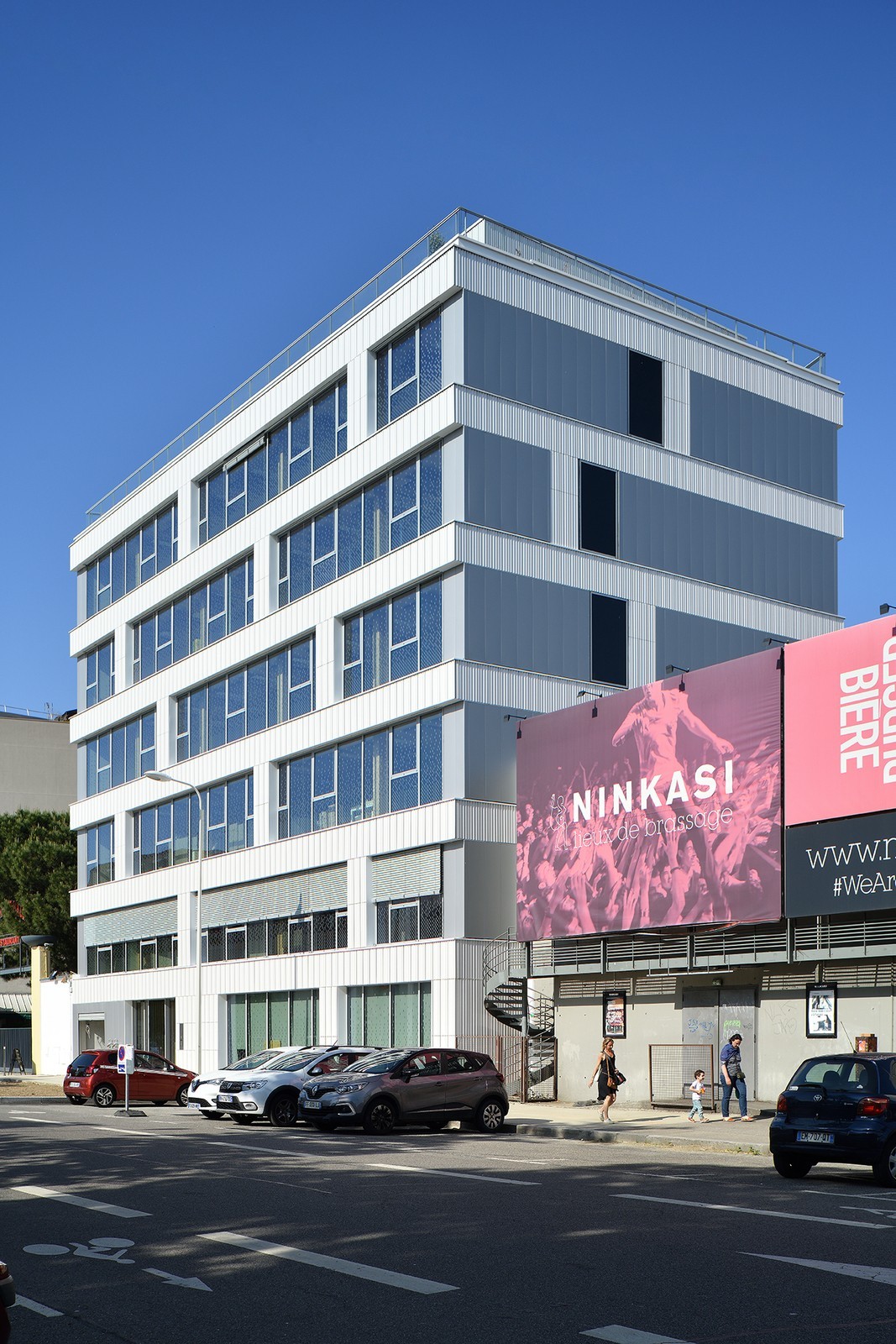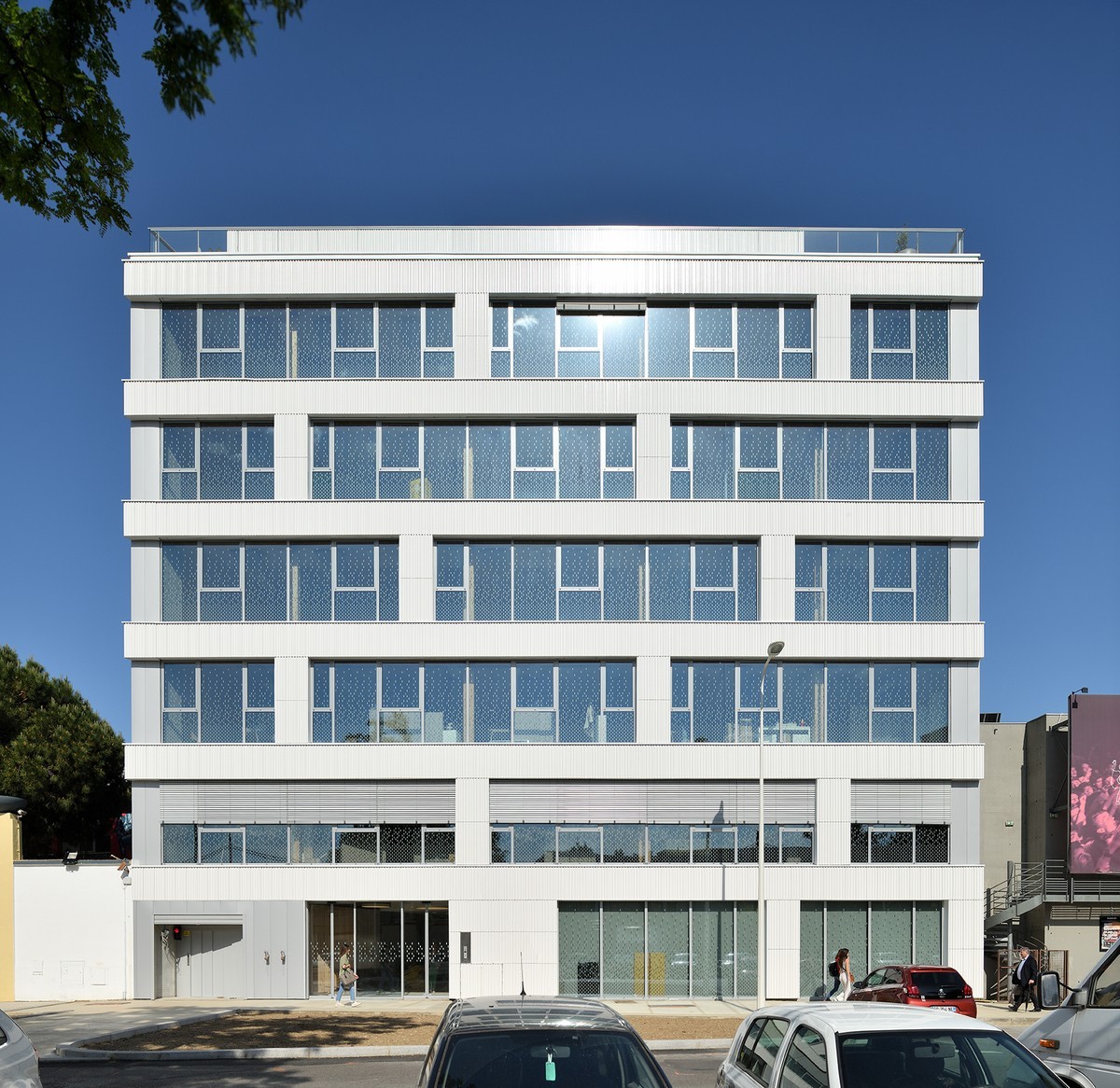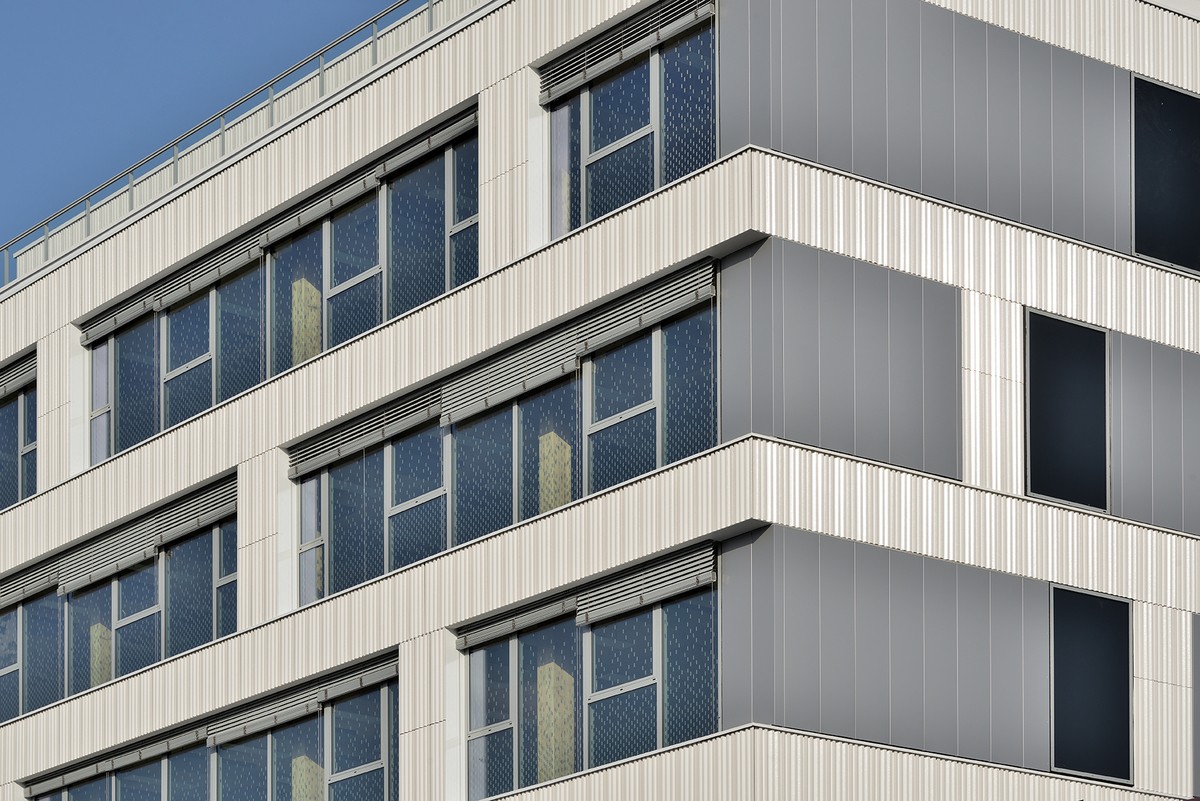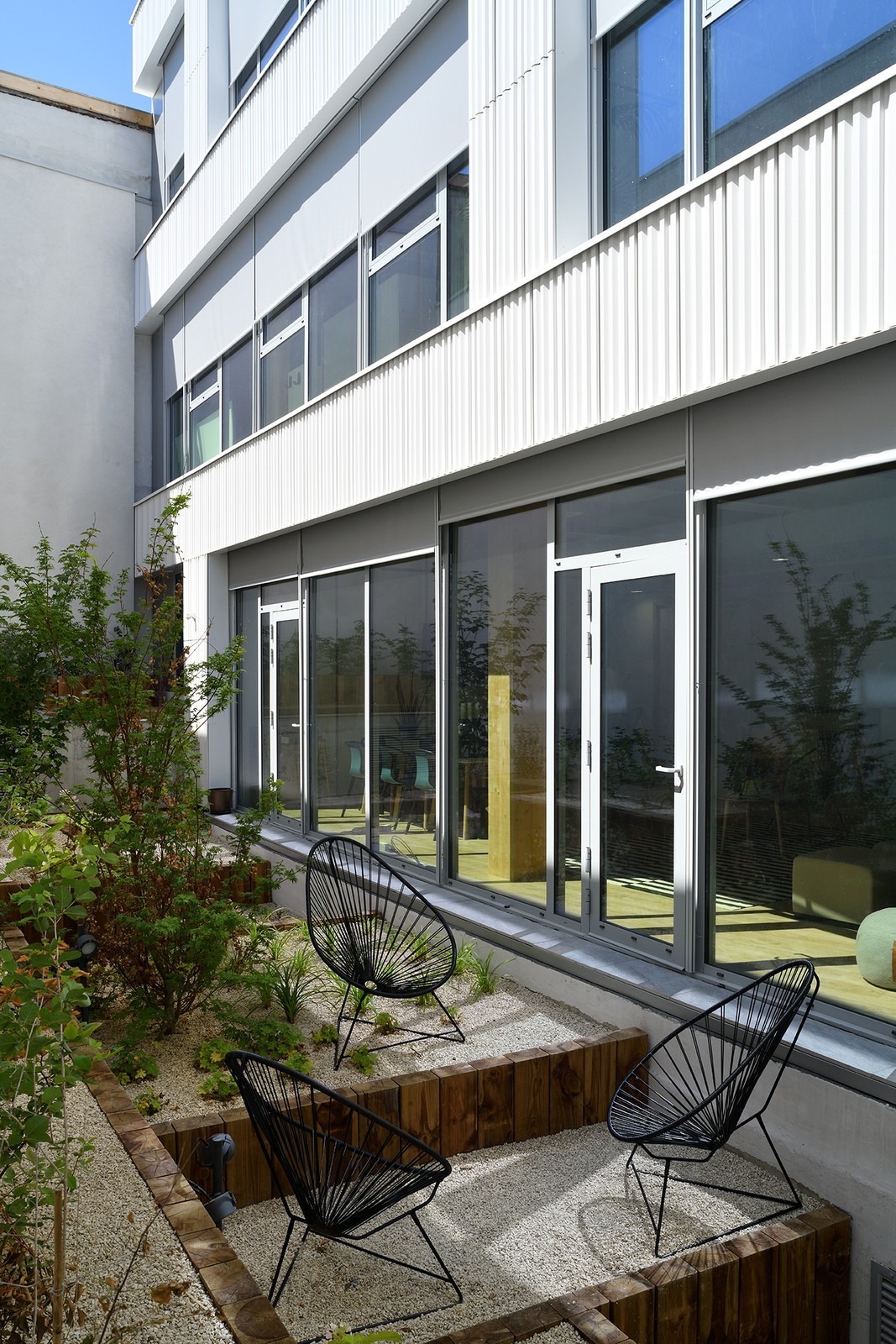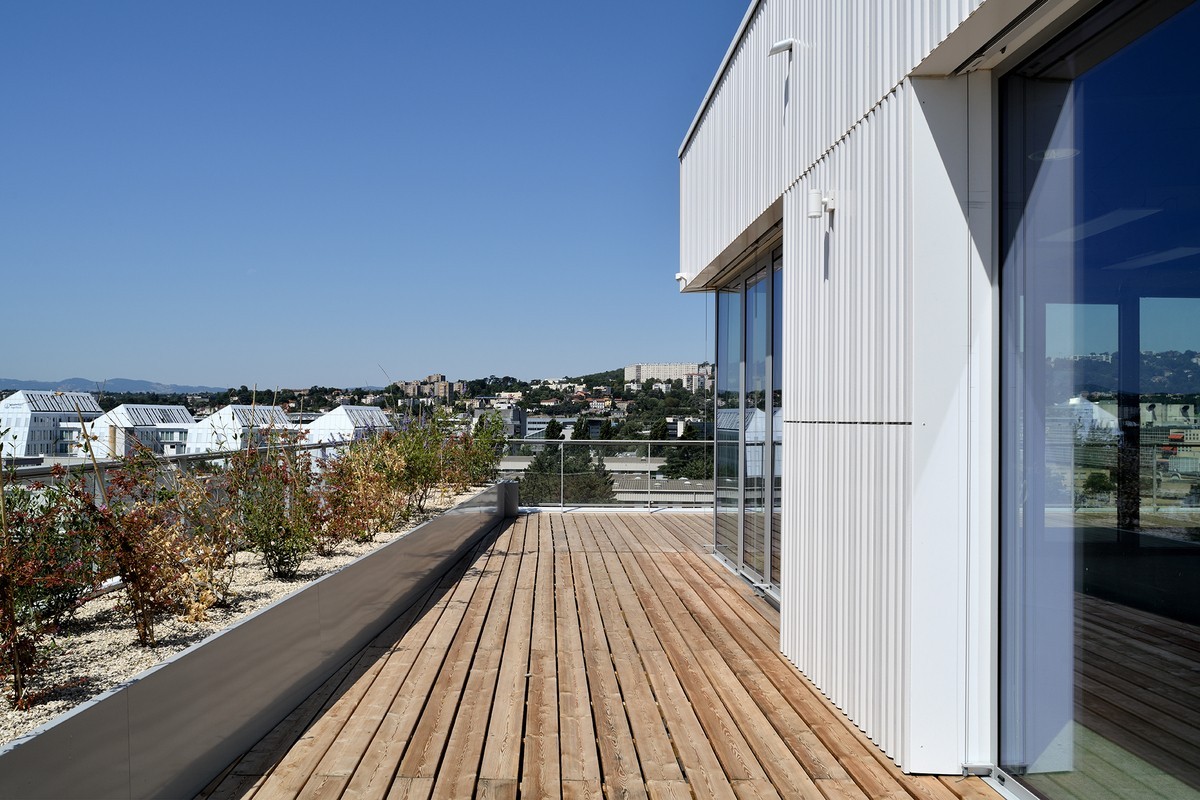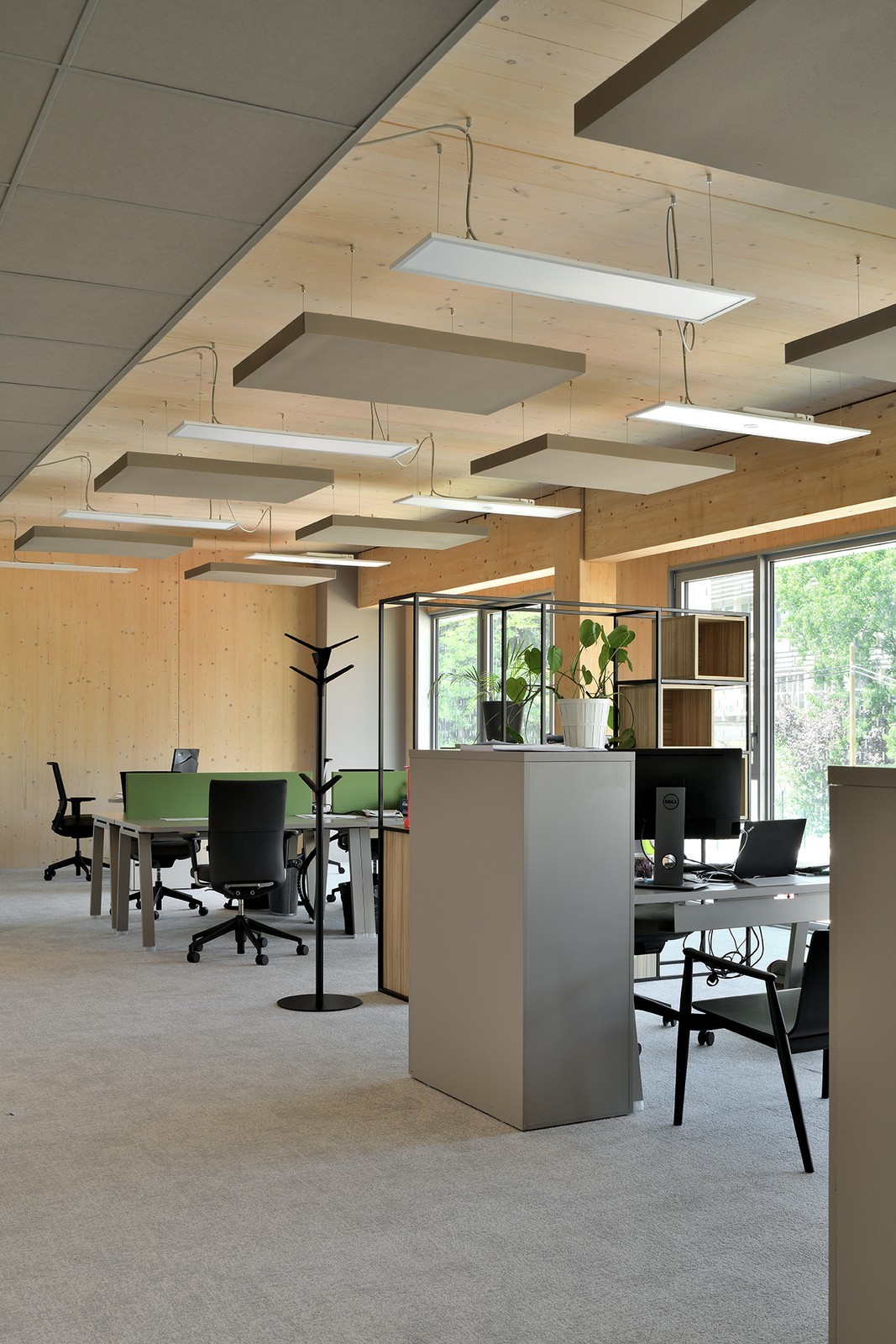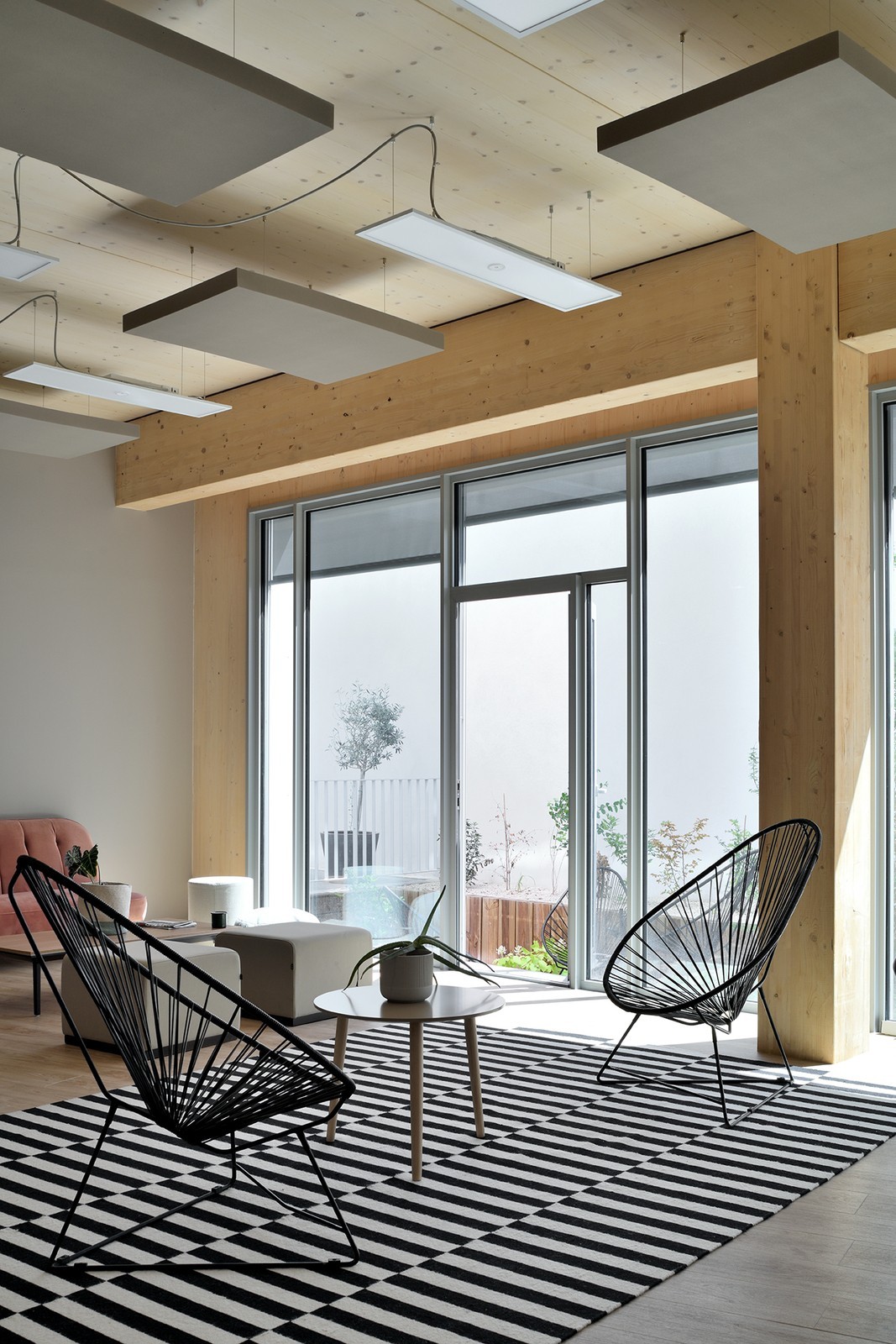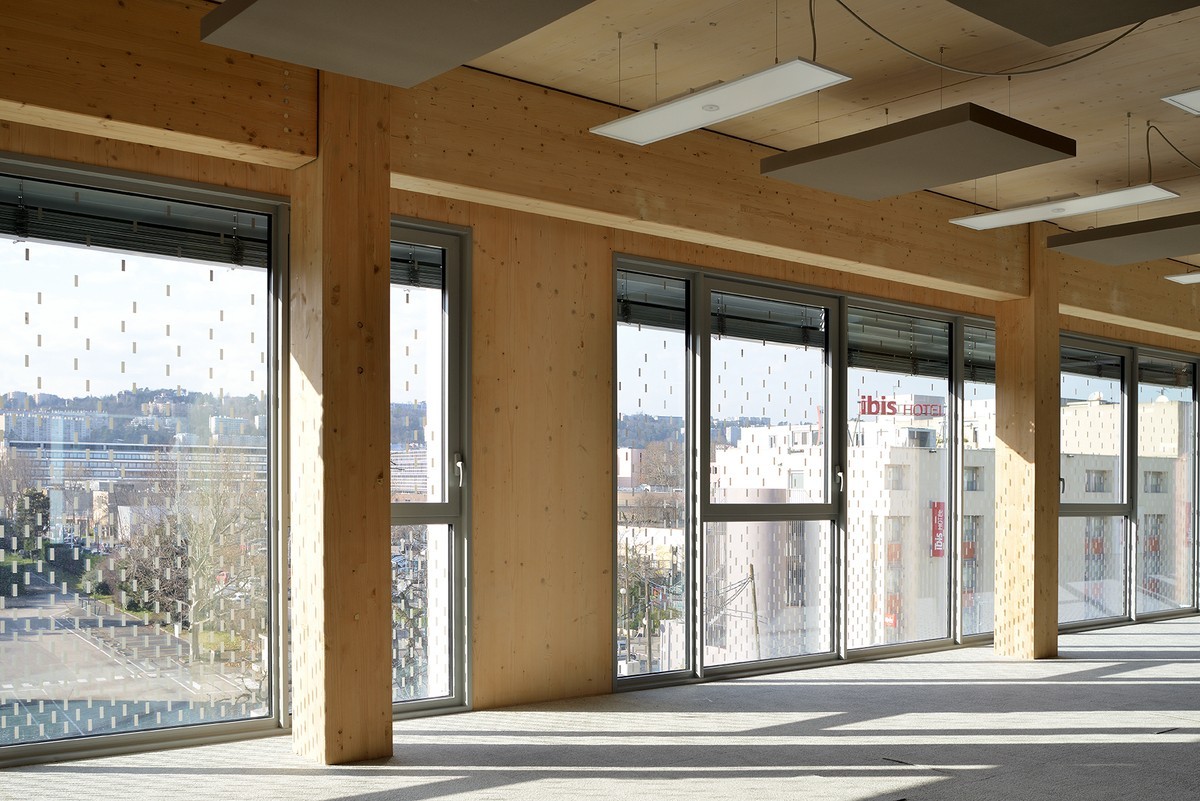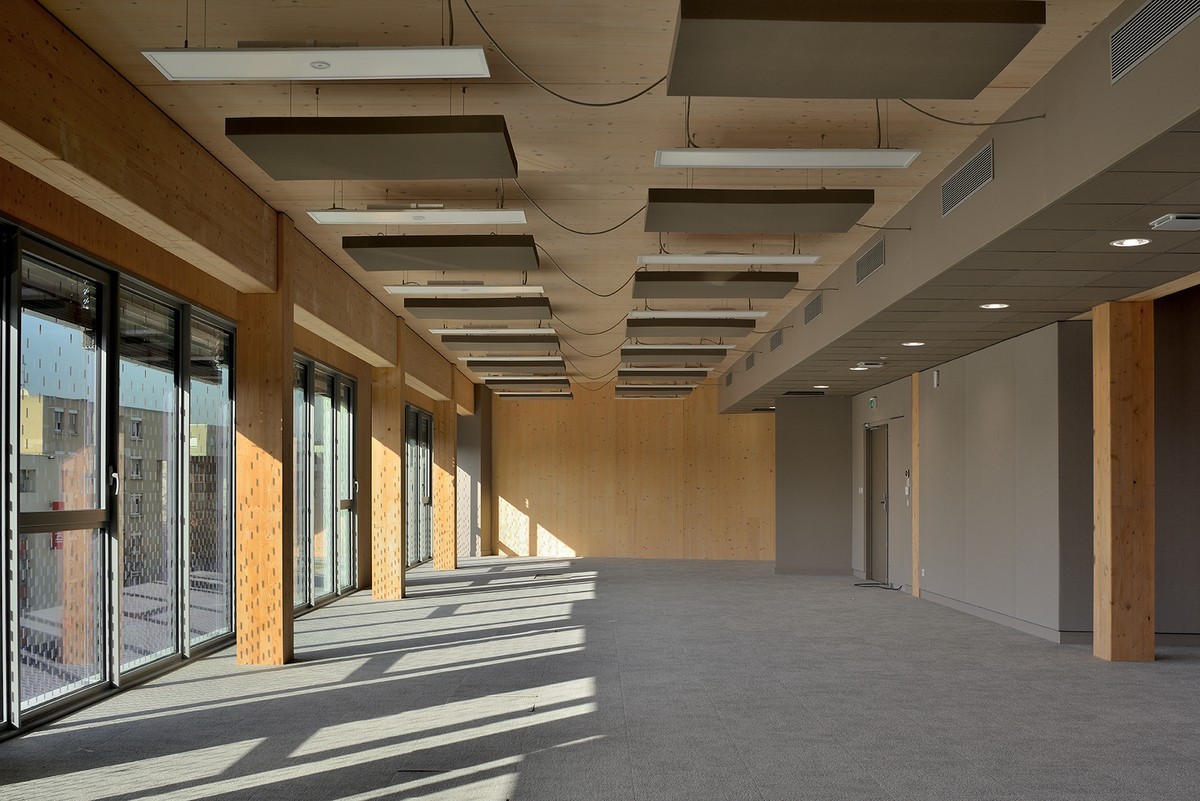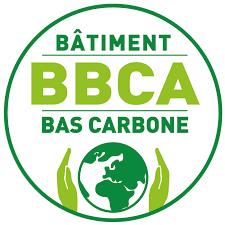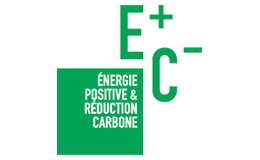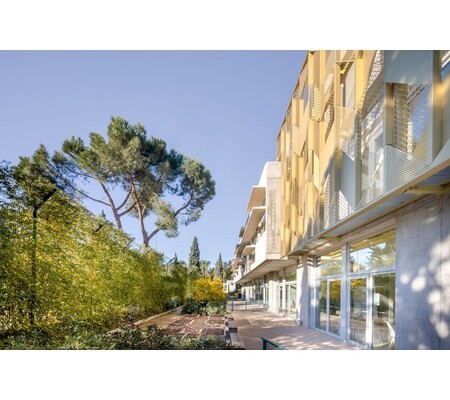Pluriel - 1st wooden tertiary building in Lyon (France)
Last modified by the author on 07/03/2023 - 11:13
New Construction
- Building Type : Office building < 28m
- Construction Year : 2020
- Delivery year : 2022
- Address 1 - street : 261 rue Marcel Mérieux 69007 LYON, France
- Climate zone : [Cfb] Marine Mild Winter, warm summer, no dry season.
- Net Floor Area : 2 331 m2
- Construction/refurbishment cost : 4 559 890 €
- Number of Work station : 202 Work station
- Cost/m2 : 1956.19 €/m2
Certifications :
-
Primary energy need
72.2 kWhep/m2.an
(Calculation method : RT 2012 )
Sustainable and efficient, while thinking about new professional uses: with the PLURIEL operation, QUARTUS has built the first office building in Lyon designed entirely in a wooden structure, certified E2C1 and BBCA excellent.
This building, made up of 6 levels and 2 203 m² of floor area, was initially designed with a concrete structure. QUARTUS, due to its raison d'être, has changed the specifications towards a wooden structure and low-carbon materials selected by the architect Régis Gachon and the EODD design office.
Pluriel was delivered to SCI Unofimmo in February 2022.
Active participation in the ecological transition
The building was designed with a very strong environmental quality approach in order to make the building more ecological, sustainable and comfortable for users, while refining the aesthetics of the facades. Thus, the building fits perfectly into its urban environment and stands out on the scale of the district
The building is certified BBCA excellent, E2C1 and is aiming for Breeam certification (very good level). It shows an RT2012 -39% level. This double certification is equivalent to a level of performance improved by 10% compared to RT2012 and attests to the exemplary nature of this building in terms of carbon footprint. The BBCA label quantifies and values, thanks to an independent certified measurement, the reduction of the carbon footprint of the building over its entire life cycle (construction, operation, end of life, carbon storage), achieved thanks to the implementation of virtuous low-carbon practices.
The concrete infrastructure has been kept to a minimum and supporte the 14 parking spaces.
The envelope and equipment have good energy performance: efficient insulation, airtight building, efficient heating, double-flow ventilation, efficient LED lighting, etc.
Solar protection optimized according to the facade (external venetian blinfs or fabric blind) limits summer overheating.
Abundant and high-quality natural lighting, as well as access to exterior views, improve the visual comfort of users.
Water consumption is controlled by the installation of economical sanitary equipment.
The quality of indoor air is particularly improved by limiting VOC and formaldehyde emissions,thanks to the construction materials used and to the installation of an efficient ventilation system.
Building users opinion
According to the surveys we conducted with occupants following their installation, it appears that they are particularly sensitive to the qualities of atmosphere, warmth and color that wood brings to workspaces.
The occupants also appreciate the top floor which has an open-air terrace, on which everyone can meet, discuss or simply relax.
Finally, the fully vegetated terrace on the ground floor, the shared kitchen and the play area are among the key benefits cited in the survey.
If you had to do it again?
The gabled facades had to be made blind (without direct views) due to the presence of lower adjoining buildings. The architect introduced a fixed opalescent bay window at each level on each gable in order to make the gable more luminous within the office plateau and to slender the gable facades from the outside. Today, in operation, we realize that these frames (non-opening) are difficult to access for cleaning.
The covered premises for parking bicycles were partitioned off from the car park by a single-leaf swing door. At the start of the construction site, on a suggestion from our investor, we installed an automatic swing door to make access to the bike room more fluid for the cyclist and his bike.
See more details about this project
https://video.enerj-meeting.com/title/immeuble-bureaux-pluriel-e2c1/https://www.groupe-quartus.com/stories/a-lyon-quartus-releve-le-defi-de-la-construction-bas-carbone/
https://nouveaulyon.fr/2022/06/30/lyon-touche-du-bois/
https://www.batimentbascarbone.org/pluriel-quartus-merieux-conception/
Photo credit
Studio Erick Saillet
Contractor
Construction Manager
Stakeholders
Construction Manager
AQTIS
Philippe BOISAN et Nicolas PIROT - contact[a]aqt.is
https://www.aqt.is/Project Manager, construction economy, OPC
Other consultancy agency
PURE INGENIERIE
Damien ROLLAND et Christian FAGES - 04 78 64 93 73
https://www.linkedin.com/company/pure-ingenierie/about/Structures, fluids and thermal design office
Structures calculist
EXACT ACOUSTIQUE
Laurent FAIGET - contact[a]exact-acoustique.com - 04 74 65 62 81
https://www.linkedin.com/company/sas-exact-acoustique/about/Assistance to the Contracting Authority
EODD
Guillaume PARIZOT et Romain CARRON - contact[a]eodd.fr
https://www.eodd.fr/Environmental AMO and environmental studies
Company
CLIMATAIR
Soufiane SELMI - climatair.rhone[a]ventimeca.com
https://www.climatair.fr/HVAC, sanitary plumbing, BMS batches
Company
BROCHIER
Jean Marc BROCHIER - 04 87 62 50 98
Electricity
Company
SOTERLY
F. BAUDRAND - soterly[a]soterly.com
Earthwork batch
Company
ELTS
https://www.eltsfondation.com/Retaining batch - deep foundations
Company
VALENTIN
Laurent SERRANO, secretariat[a]valentin-sa.com
https://www.entreprisevalentin.fr/Structural work and insulation batches
Company
FAVRAT CONSTRUCTION
Pascal FAVRAT - info[a]favrat.fr
https://www.favrat-ossature-bois.fr/Wood frame batch
Company
SOPREMA
https://www.soprema.fr/fr/Sealing
Company
SOMIROC
Cyrille MINODIER
https://bsrv-groupe.fr/revetement-facade-sol/entreprise/Cladding batch
Company
AMALGAME
Raphaël DEVILLIERS - 04 37 22 13 13
Exterior carpentry, aluminum and occultations batches
Company
ASCR CELLUPICA
Eric CELLUPICA
https://www.ascrcellupica.fr/Locksmith-metalwork
Company
SCHINDLER
https://www.schindler.fr/fr.htmlElevator batch
Other consultancy agency
Builders&Partners
Yann BRUNEL
https://www.b-p.fr/Facade design office
Company
NORBA RHONE ALPES
Mme BACCICHETTI - 04 72 68 68 00
https://www.norba-menuiserie.com/agence/rhone-alpes/Interior carpentry batch
Company
MT CORPORATION
Reusable false floors batch
Company
AUBONNET
Yvan AUBONNET
Partition linings, false ceilings, paintings, wall coverings and flexible floors batches
Assistance to the Contracting Authority
SAS ECOH
Hervé COSTEL
https://www.linkedin.com/in/hervecostel/?originalSubdomain=frContracting method
Separate batches
Type of market
Global performance contract
Allocation of works contracts
Separate batches
Energy consumption
- 72,20 kWhep/m2.an
- Heating: 20.80 kWhep/m²
- Cooling: 21.20 kWhep/m²
- DHW: 6.30 kWhep/m²
- Lighting: 7.90 kWhep/m²
- Auxiliaries: 16.10 kWhep/m²
Envelope performance
- 0,71 W.m-2.K-1
- 0,35
- 0,74
More information
Commissioning after 1 year has not yet been carried out.
Systems
- Others
- Fan coil
- Individual electric boiler
- Others
- Fan coil
- Double flow heat exchanger
- No renewable energy systems
Biodiversity approach
- Installation of an extensive green roof with plant palette.
- Installation of refuges for small fauna (insect hotel, birdhouses and bat dormitories).
- Vegetation of a courtyard ensuring 84% of native and non-allergenic plant species and 3 different planting strata (tree, shrub and herbaceous). Plant species are favorable to fauna (berry and/or melliferous species): 45% individual trees and shrubs, 41% of the herbaceous layer contains melliferous species.
- No creation of deadly traps.
- Limiting light pollution.
Urban environment
- Immediate proximity to metro line B linking the Part-Dieu station;
- Proximity to line n° 1 of the tram, main line of the agglomeration.
- 472,00 m2
- 89,00 %
- 53,00
Product
CLT superstructure (columns, beams, floors and walls)
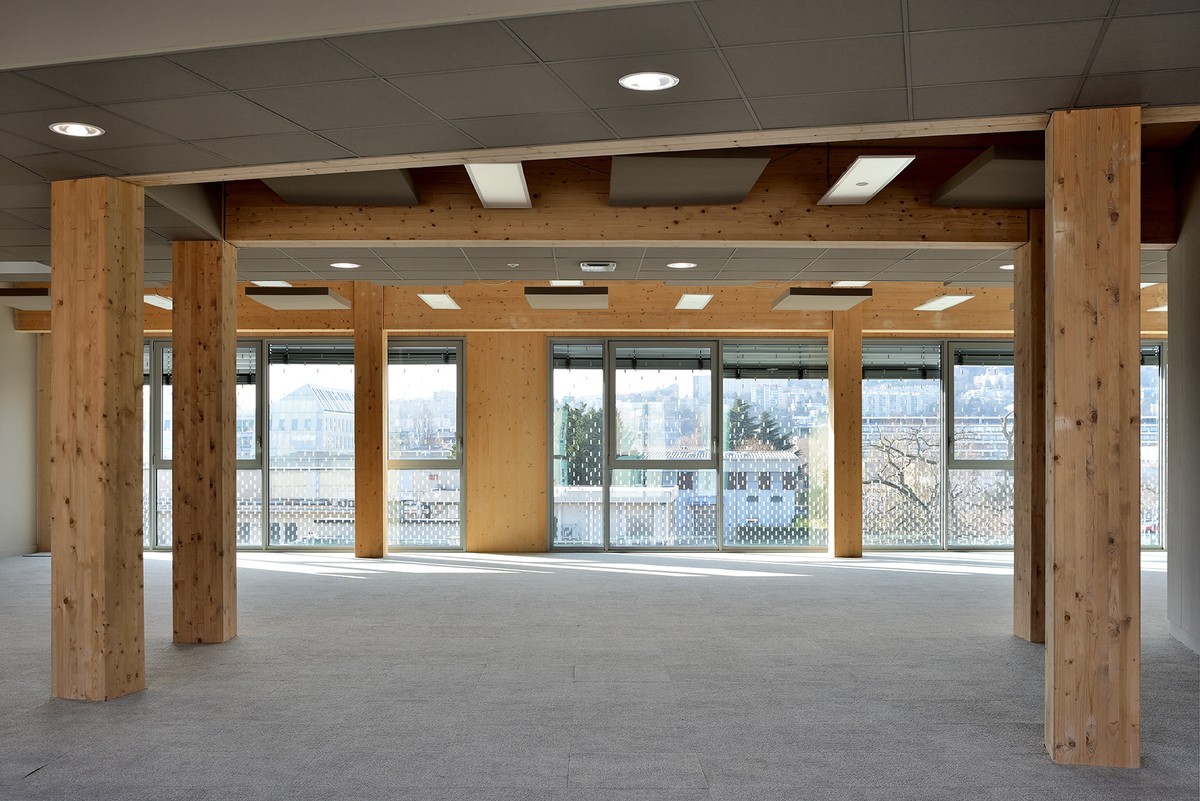
KLH
https://www.klh.at/Structural work / Carpentry, cover, titghtness
The volume of wood used for this construction is significant (nearly 30 m3) and constitutes a real carbon sink for the environmental performance of the building.
Plancher MOBIUS
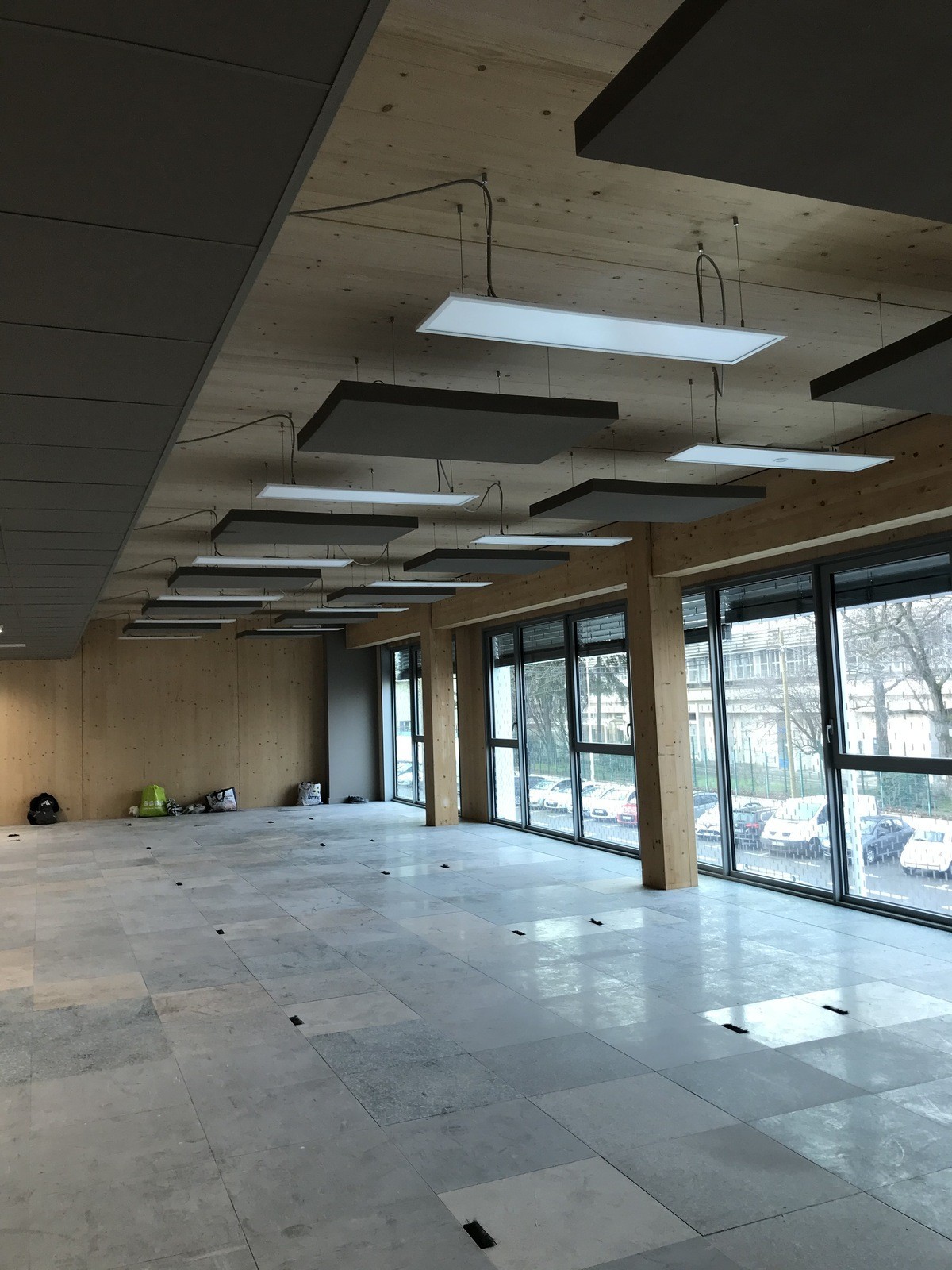
MOBIUS REEMPLOI
contact[a]mobius-reemploi.fr
https://www.mobius-reemploi.fr/Finishing work / flooring
The false floor comes from a resource reconditioned by MOBIUS.
External venetian blinds, differentiated solar protections
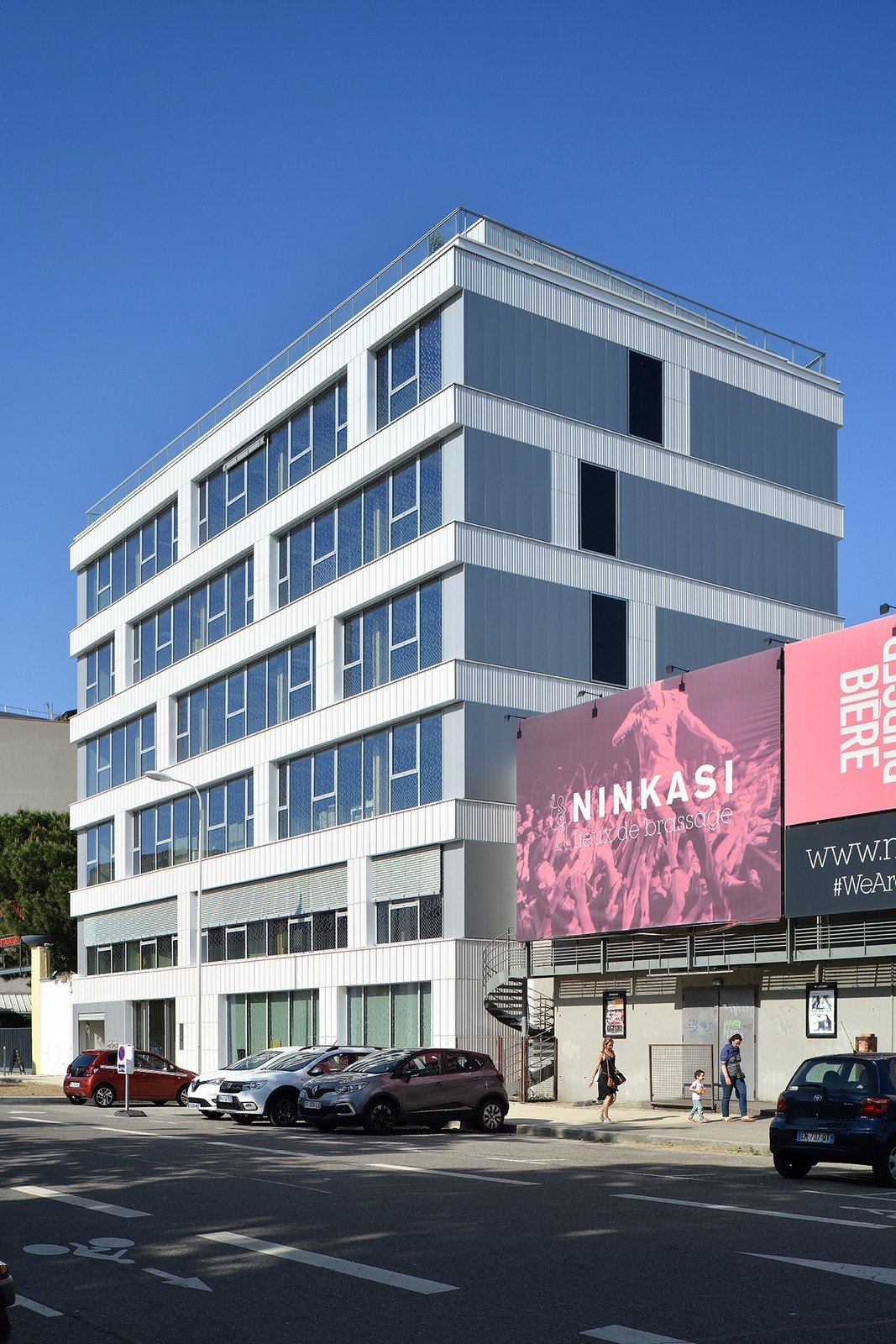
GRIESSER
http://www.griessergroup.comFinishing work / Exterior joinery - Doors and Windows
The reflection on the types of concealment between external rolling venetian blind and external blinds has also been pushed to the carbon weight level. This is why the use of external rolling venetian blind was proposed on the west facade, and exterior blinds on the east facade.
Construction and exploitation costs
- 692 220 €
- 5 391 820 €
Circular economy strategy
- Choice of non visible products
- Maximization of the carbon gain
Reuse : same function or different function
- Raised floors
- Product: Dall'R30B type false floor slabs from MOBIUS, made up of high-density chipboard panels, 30 mm thick and a folded treated steel sheet tray, 0.5 mm thick, on the underside and rising on the peripheral sides
- Quantity: 1,742 m²
- Traceability of the supplier MOBIUS tells us that it comes from 2 sites:
- 110 avenue Edouard Vaillant - 94 800 VILLEJUIF
- 21-25 avenue Matignon - 75008 PARIS
- Reconditioning of the tiles by the supplier and reuse
Logistics
- No storage on site, but financial contribution for storage by the material supplier on his site
Insurance
Environmental assessment
- 113 tonnes of CO2 avoided
- 1 360 kg of water consumed avoided
- 77 tonnes of waste avoided
Economic assessment
- 25 000 €
- Purchase by the company from a reuse platform
Communication
Circular design
- Selective demolition of the existing building (aimed at recycling 3 types identified in the waste diagnosis);
- Concrete infrastructure limited to the minimum (a single level made of concrete);
- Superstructure made of wooden frame (columns, beams, floors and walls in CLT).
- Replacing aluminum blinds with exterior screen blinds on the east facade of the project;
- Selecting facade materials that reduce the environmental weight of the facade while maintaining the exterior appearance expected of a commercial building adapted to its urban environment. The fibre-reinforced concrete cladding initially planned for the east and west facades was replaced by Alphaton enamelled terracotta cladding from Moeding and the opaque glass curtain wall with aluminum profile in the gables was replaced by ST900 steel cladding from Arval;
- Selecting materials from reuse (reconditioned Mobius false floor) and a carpet made mostly of recycled materials (Milliken).
Indoor Air quality
- Distance from fresh air intakes and discharge of 8 meters;
- Control of the TVOC of construction products (class A+ in the majority, class A minimum required);
- Adapted ventilation system: AHU filtration, M5 (returned air) + F9 (fresh air);
- Regulation, sealing and maintenance of the aeraulic network: class B for aeraulic networks;
- Recommendations on indoor air quality included in the lessee's specifications.
Comfort
- Heating: 19°C, basic outdoor winter conditions in Lyon (69), i.e. -10°C;
- Cooling: reduction of 6°C compared to nominal summer conditions, i.e. 26°C inside for 32°C outside with drift beyond this temperature.
- Isolation from outside noise (after measuring environmental noise);
- Isolation from interior noise;
- Limitation of impact noise from one level to another;
- Limitation of equipment noise perceived in office spaces;
- Limiting the acoustic reverberation of noise in open office spaces.
Quality of life and services
Wood being 12 times more insulating than concrete, the living environment suffers. The environmental qualities of wood go so far as to affect the health of the occupants, since wood promotes better indoor air quality thanks to its hygrothermal buffer properties. This material also provides significant acoustic insulation promoting the comfort of the occupants.
General infos
- Level reached: BBCA Excellent
Carbon sink
Wooden superstructure (columns, beams, floors and facade in CLT)
-265 kg CO2eq/m² SDP
Initiatives promoting low-carbon mobility
- A few bike spaces on the ground floor on the inner courtyard side;
- Bike room in the basement with automatic open door to facilitate maneuvers with one's bike;
- Few car spaces (14 spaces), encouraging travel by public transport, on foot or by bicycle.
GHG emissions
- 5,78 KgCO2/m2/an
- 782,00 KgCO2 /m2
- 50,00 année(s)
Life Cycle Analysis
- Definition of the objectives and scope of the study (functional unit, boundaries, etc.);
- Life cycle inventory (accounting balance sheet of withdrawals and discharges);
- Assessment of the impact of the life cycle (transition of flows into impact categories and impact modeling);
- Interpretation (verification, sensitivity studies, use of results).
- Construction products and equipment (“components”);
- Energy consumption;
- Water consumption and discharge;
- Worksite.
- Existing deconstructed surface: 900 m² SDP according to building permit dated April 2019;
- Project area: 2 213 m² SDPaccording to building permit dated April 2019.
Reasons for participating in the competition(s)
Construction en bois, réemploi et matériaux biosourcésCe bâtiment tertiaire, de six niveaux, est une construction innovante, réalisée à 70% en construction bois et en matériaux biosourcés. Outre les gains sur l’énergie grise de l’ouvrage, ce parti pris structurel assure un stockage carbone biogénique de plus de 500 T de CO2 équivalent. Conscients que tout matériau neuf engendre une consommation d’énergie et de ressources supplémentaires, la volonté de mettre en place une démarche d’économie circulaire sur le projet a également émergé rapidement. Le recours à des dalles de faux planchers issues du réemploi permet notamment d’économiser 100 tonnes de CO2 équivalent.
Promoteur, architecte, écologue : tous unis autour du bas carboneLe processus de conception bas carbone nécessite un travail itératif entre l’architecte et les bureaux d’études pour cerner en amont les postes à prioriser à chaque phase du projet. En particulier, le choix des protections solaires a fait l’objet d’une analyse comparative pour trouver le meilleur compromis entre confort d’été et impact carbone. Le confort et la place du vivant dans l’opération Pluriel ne sont pas oubliés : un plan de qualité de l’air intérieur a été décliné et les aménagements extérieurs ont pris en compte les préconisations d’un écologue pour favoriser les micro-habitats pour la faune et la flore.
« En complément de la performance environnementale et énergétique du bois, notre travail architectural a consisté à manifester les qualités d’ambiance, de chaleur et de couleur, que ce matériau apporte à l’espace de bureaux. Il s’agissait donc de sortir du schéma classique du faux plafond de bureaux qui recouvre le plancher et de laisser « libre » le plancher bois qui devient le plafond anobli de l’espace de travail » précise Régis Gachon, architecte de Pluriel.




